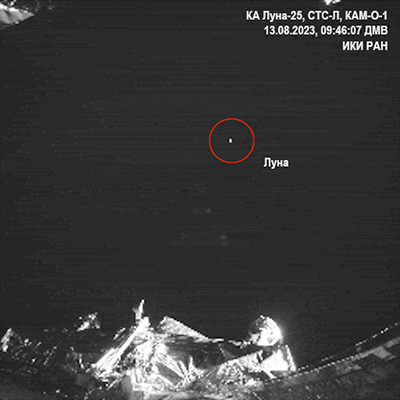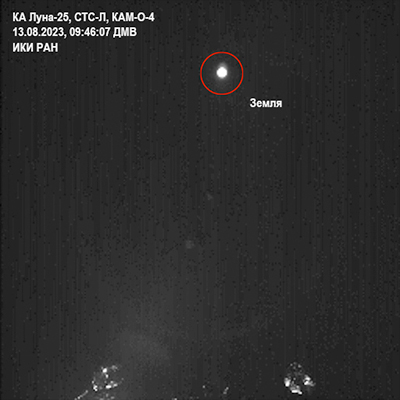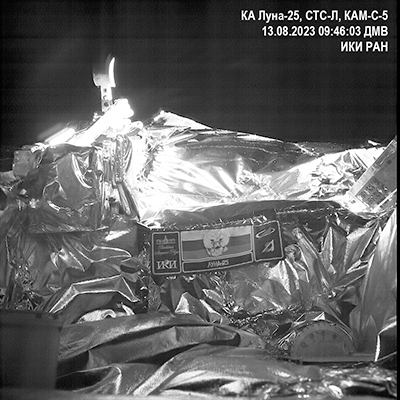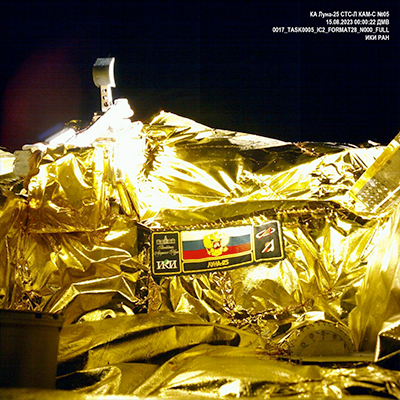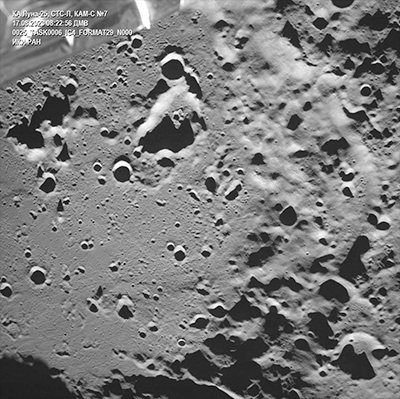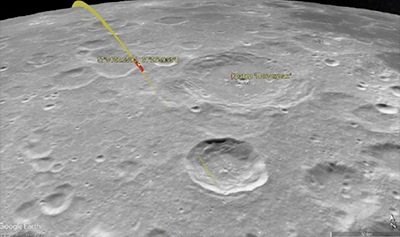Luna-25: Back to StayA little more than half a century ago, at the end of the "lunar race," few people doubted that very soon the moon would turn into a full-fledged "seventh continent" of our planet. Soviet engineers and designers even designed base-cities for future colonists. None of this happened — in the mid-1970s, humanity suddenly lost interest in this celestial body. At that moment, it seemed like forever.
But the scientific discoveries made in the last couple of decades have changed the situation — the development of Earth's satellite has again been taken seriously.
In the summer of 2023, Russia does not just return to the Moon, but takes a step towards staying there for a long time - already in August, the Luna 25 automatic interplanetary station goes into flight.
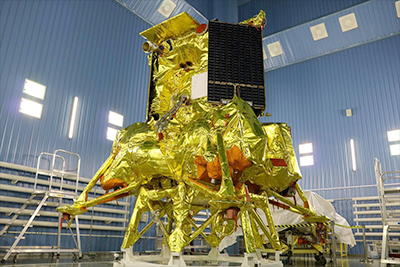
Unpause the moon
In the mid-1990s, scientists proposed the creation of an orbital station for seismic research on the moon: the device was supposed to be equipped with ten small impact probes - penetrators. At the same time, a descent vehicle with scientific instruments was to be landed in the polar crater to search for frozen water. The project was named Luna-Glob. Alas, in those years, priority was given to the study of Mars and there was not enough money for other studies, so for several years the plans remained on paper.
They returned to the project in the mid-2000s, but in the process of work, the idea underwent significant changes several more times. So, the penetrators were abandoned due to difficulties with their development. For some time, the landing module also disappeared from the Luna-Glob project — the study of the polar regions of the Earth satellite was entrusted to the Luna-Resource apparatus, work on which was carried out in parallel. The mission took on its final form only in the 2010s. In Roscosmos, they settled on the option with a landing station that will conduct research in the region of the south pole of the moon.
In 2013, the device created as part of the mission was named Luna-25. This was to emphasize that the work on the study of the Earth's satellite, begun by Soviet scientists and designers, continues. The development of the station was entrusted to the Lavochkin Scientific and Production Association (NPO) - the enterprise had extensive experience in creating interplanetary vehicles, and all the "Lunniks," starting with "Luna-9," were made here.
A sensitive blow to the preparation of the Luna-25 mission was dealt by the unsuccessful launch of the Russian interplanetary station, Phobos-Grunt. It was supposed to go to the Martian satellite Phobos, but it never managed to leave Earth's orbit. It was planned that Luna-25 would use a lot of service and scientific instruments developed for this device, but after the failure, the concept had to be revised and part of the components and devices developed from scratch.
"Luna-25" will be the first interplanetary station in more than 40 years, which our country will send to the Earth's satellite. Its main task is to work out the technology of soft landing near the south pole in order to create a reserve for already planned missions and to conduct the first scientific research in the circumpolar region of the moon.
In the coming years, Russia plans to launch the Luna-26 orbiter, which will remotely study the Earth satellite, in particular, map the distribution of water ice on its surface. The NPO named after Lavochkin is already working on the creation of this station. There are two more missions to follow. The Luna-27 lander will study the regolith and the ice contained in it in the region of the South Pole of the Moon, and the Luna-28 should deliver the regolith with ice to Earth.
Automatic Interplanetary Station 'Luna-25'
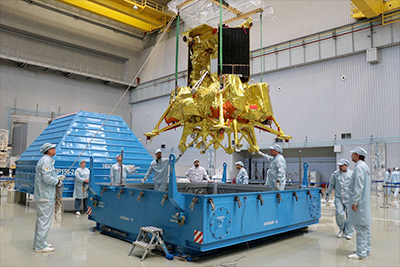
"Luna-25" consists of two main structural parts. The main part of its scientific equipment and service equipment necessary to maintain the life of the probe were placed in the upper one.
The more massive lower part is the landing gear. Here are shock-absorbing supports, station engines, fuel tanks, part of the antennas of the communication system, as well as scientific instruments - a manipulator, an active neutron spectrometer and a lunar dust recorder.
The flight and operation of the station will take place in extreme conditions: at night at the south pole of the moon it gets cold to -170 degrees C, while during the day it becomes unbearably hot - about +120 degrees C.
The main source of heat for the onboard equipment in the upper part of the vehicle will be a plutonium-based radioisotope thermoelectric generator (RTG). It will warm the instruments not only during the flight, but also during the entire period of the station's operation on the lunar surface. The devices at the bottom also use heat from the decay of plutonium - the radioactive metal will be in devices called RHS (radioisotope heat source).
In addition to heating the equipment, the RITEG will perform another, no less important function - it will provide electricity to the real-time clock installed at the interplanetary station. Before the onset of the moonlit night, all scientific equipment will be turned off. In the morning, the clock, set as a wake-up timer, will signal the on-board computer to resume work.
To maintain a comfortable microclimate for the equipment of the apparatus, a special shell will also help - screen-vacuum thermal insulation (EVTI), with which the apparatus is almost completely wrapped. It consists of several dozen reflective screens - silver-coated synthetic material - between which is a fibrous material with low thermal conductivity. Outwardly, EVTI resembles foil, and to the touch it looks like thermally insulating bags in which frozen foods are transported.
It will be possible to regulate the temperature of the sustainer engine during the flight using a cover that closes the nozzle of the probe engine. If it becomes too hot under the EVTI shell, the lid will be slightly opened - just like you open a window pane. As soon as the temperature returns to normal, it will be closed again. Before the landing of Luna-25, the cover will be shot off so that it does not interfere with the operation of the engine.
The onboard integrated computer complex (BIVK-R) will be responsible for all control of the station equipment, including communication with the Mission Control Center located on Earth. It will also make decisions on control during landing.
The soft landing itself will be provided by a Doppler velocity and range meter (DISD-LR). The device will send to the moon and receive signals reflected from its surface - this will allow you to receive data on the altitude of the device, its speed and angles of inclination at any time.
Landing site
The choice of landing site became one of the key issues of the entire mission. So that the station does not capsize at the moment of landing, in this area - an ellipse with axes of 30 and 15 km - there should be no steep slopes (more than 15 degrees) and large stones. Equally important is the good illumination of the area for charging solar panels and the ability to constantly maintain radio contact with the Earth - this will allow the device to effectively perform scientific tasks. And of course, the area of the future lunar landing was chosen taking into account the wishes of scientists. After long discussions, the scientific leadership of the Luna-25 mission settled on three landing areas: the main one, just north of the Boguslavsky crater, and two reserve ones, southwest of the Manzini crater and southwest of the Pentland crater.
Scientific payloads
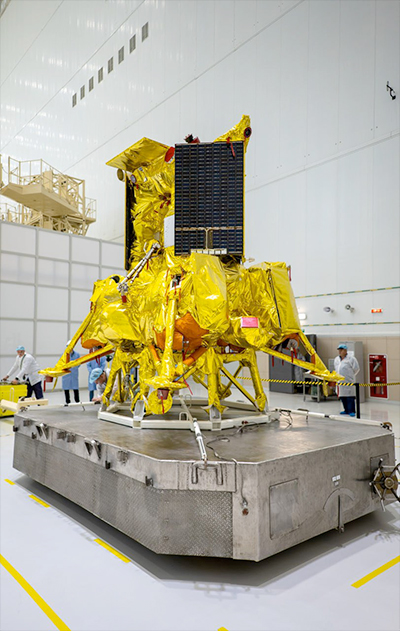
Solar panels will provide the onboard equipment of the Luna with the necessary electricity. Their position is somewhat unusual. On devices operating in the equatorial zone, the batteries are fixed parallel to the surface - it is easier to capture light from the Sun at its zenith. However, in the region where the Russian station will land on the moon, the star will not rise higher than 20 degrees above the horizon. To prevent the equipment from experiencing a shortage of electricity, solar panels were installed perpendicular to the lunar surface.
- LMK
The Lunar Manipulator Complex (LMK) is called by scientists the highlight of the entire project. With the help of this one and a half meter mechanical arm with a bucket, researchers will be able to dig up the lunar surface and take samples of regolith for analysis from different depths - for this, there is a special soil collector at the end of the manipulator. The external simplicity of the device is deceptive: in order to achieve its reliable operation, engineers had to conduct many tests. For tests, they even created artificial soil, which in its properties is close to the lunar one. The test results are encouraging: LMK not only successfully copes with loose loose regolith, but is also able to dig "permafrost", which may well be found in the lunar Arctic.
- LAZMA-LR
The regolith collected by the manipulator will be delivered to the LAZMA-LR device - a laser mass analyzer. In it, soil samples will be heated, evaporated and ionized by a laser. As a result of these actions, charged particles are formed - ions. Their analysis will allow scientists to determine the chemical, elemental and isotopic composition of the regolith at the landing site of Luna-25. In total, it is planned to analyze 11 such samples taken from different places and depths during the operation of the station.
The spacecraft has two more devices for remote study of the lunar soil.
- LIS-TV-RPM
During the day, the surface of the Moon will heat up and radiate heat, so the lunar infrared spectrometer with television support for the working field of the manipulator (LIS-TV-RPM) will be able to analyze the mineralogical composition of regolith in the infrared spectrum.
- ADRON-LR
The active detector of neutrons and gamma rays (ADRON-LR) will "fire" the regolith with neutrons from the built-in pulse generator. An analysis of the spectra of gamma rays and neutrons emitted from the regolith will allow not only to find out whether there is water ice in the ground, but also to estimate its amount and understand how it is distributed in depth.
STS-L
Service television system "Luna-25" (STS-L) consists of eight cameras. Two of them are below the engine and will be filming during the lunar landing of the device. Four wide-angle panoramic cameras located at the top of the station will start working during the descent, and after landing they will make a circular panorama. Finally, two more stereo cameras look at the manipulator and its working area. For scientists on Earth, they will become a kind of eyes - they will help to choose the most interesting places for digging and taking soil samples. The operation of these two cameras is closely related to the operation of the LIS-TV-RPM device. Information from all cameras will be sent to the data collection and processing unit, and then transmitted to Earth.
It is planned to study the exosphere of the Moon with two instruments.
- ARIES-L
The ARIES-L panoramic analyzer of ions and neutrals will study the illuminated surface of the Moon and register ions knocked out of it by the solar wind. The device will determine the charge and mass of each of the ejected particles and provide information on the elemental composition of the upper layer of regolith. In addition, he will analyze the general composition of the near-surface plasma and the dynamics of its changes in the exosphere, as well as study the plasma of the solar wind.
- PML
Mounted on the Dust Monitor (PML), sensor sensors will register the impacts of lunar dust particles and measure their charge and mass. In addition, the device will be able to measure electric fields near Luna-25.
- REBELL
The last, eighth device of the "moon" is technological. The Scientific Information Control Unit (BUNI) combines scientific instruments (except STS-L) into one system: it controls the process of their operation, controls the power supply and transmits control commands from the Earth. In fact, this is the brain of the entire scientific part of Luna-25.
Life of Luna-25 According to the employees of IKI RAS, they do not build big work plans for the first lunar day. Most likely, the time after the landing and before nightfall, experts will spend studying the conditions at the landing site and testing the equipment to make sure that it safely endures the journey to the moon.
The main work is scheduled for the second lunar day and beyond. For two Earth weeks, shifts on duty will monitor the operation of the device around the clock: give commands to the device, receive scientific data and telemetry from it, analyze information, and possibly make emergency decisions if something goes wrong.
It is expected that the device will be able to work on the Moon for a year, and for the employees of the Lavochkin NPO and the IKI RAS, this will be a busy time in every sense.
According to experts, Luna-25 is now ready for flight. All of its units and equipment passed the necessary checks, and before sending the station to the cosmodrome, the NPO named after Lavochkin conducted acceptance and delivery tests. On July 11, the apparatus was delivered to Vostochny by plane and by road.
Path to the moon
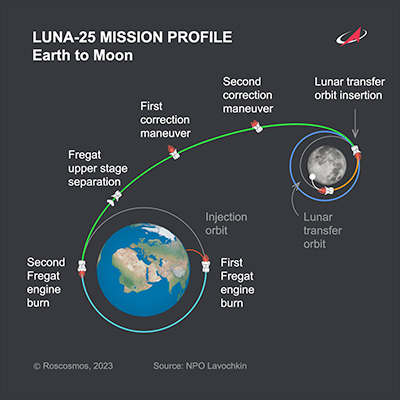
Above: Luna-25 mission profile: Earth to the moon. (Roscosmos; English translation by Katya Pavlushchenko)
Approximately ten and a half minutes after the launch, the upper stage and the spacecraft will be in the so-called closed reference orbit. Here, at an altitude of about 200 km above the Earth, they will spend about an hour and enter the trajectory of the flight to the moon.
Turning on the engines of the upper stage will allow Luna-25 to overcome gravity and begin a journey to the satellite of our planet.
The station will fly along an elliptical trajectory. Over the next ten days, the Mission Control Center (MCC) will work around the clock, conducting communication sessions with the station every two hours.
At a distance of about 3 thousand km from the Earth, the spacecraft will separate from the upper stage.
At this moment, Luna-25 will move at a speed of 8.9 km/s, and the momentum transmitted to it will be enough for it to travel the rest of the way on its own.
After a day and a half, when the spacecraft will be at a distance of about 230 thousand km from the Earth (the average distance between our planet and its satellite is about 384.5 thousand km), it is planned to carry out the first correction of the trajectory of its movement. The MCC specialists will briefly, literally for 20 to 30 seconds, turn on the Luna-25 low-thrust engines. However, if the device will fly along an ideal trajectory, the maneuver will not be required.
The re-correction of the movement is planned approximately a day before approaching the Moon. By this time, the spacecraft will have covered 340,000 km in airless space. To change the trajectory, it is again planned to use only small thrust engines.
The main - marching - engine will turn on for the first time only at the moment the device enters the initial circumlunar orbit. In order for the gravitational field of an earthly satellite to capture the station, it is necessary to extinguish its speed. Luna 25's engines will run for about five minutes and use up a significant portion of the fuel in the tanks.
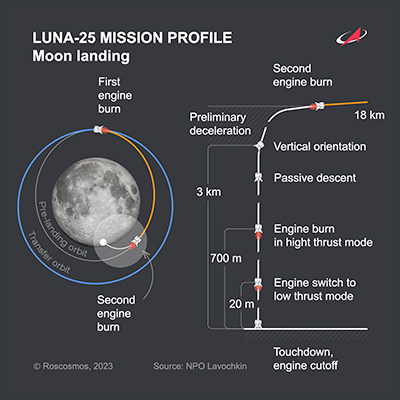
Above: Luna-25 mission profile: Moon landing. (Roscosmos; English translation by Katya Pavlushchenko)
In a circular 100-kilometer orbit, the station will spend the next three days, making 36 orbits around the moon. The plane of motion of the station will be approximately perpendicular to the direction from the Moon to the Sun. This allows you to get a lunar orbit without shadow areas and provide the necessary amount of electricity from solar panels.
On the fourth day, MCC specialists will form a landing orbit for the station. It will be elliptical, and during the passage of periselenium (the point at the minimum distance from the Moon), the apparatus will be only 18 km from the surface of the earth's satellite. The spacecraft will spend two more days in this orbit, completing 24 orbits. And then, perhaps, the most important and exciting part of the whole journey will begin - landing.
















